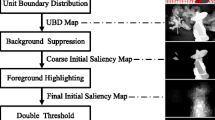Abstract
Salient object detection has witnessed rapid progress, despite most existing methods still struggling in complex scenes, unfortunately. In this paper, we propose an efficient framework for salient object detection based on distribution-edge guidance and iterative Bayesian optimization. By considering color, spatial, and edge information, a discriminative metric is first constructed to measure the similarity between different regions. Next, boundary prior embedded with background scatter distribution is utilized to yield the boundary contrast map, and then a contour completeness map is derived through a wholly closed shape of the object. Finally, the above both maps are jointly integrated into an iterative Bayesian optimization framework to obtain the final saliency map. Results from an extensive number of experimentations demonstrate that the promising performance of the proposed algorithm against the state-of-the-art saliency detection methods in terms of different evaluation metrics on several benchmark datasets.










Similar content being viewed by others
References
Bai X, Wang W (2014) Saliency-svm: an automatic approach for image segmentation. Neurocomputing 136:243–255
Ren Z, Gao S, Chia L-T, Tsang IW-H (2014) Region-based saliency detection and its application in object recognition. IEEE Trans Circuits Syst Video Technol 24(5):769–779
Hadizadeh H, Bajic IV (2014) Saliency-aware video compression. IEEE Trans Image Process 23(1):19–33
Gao X, Shi X, Zhang G, Jin L, Liao M, Li KC, Li C (2018) Progressive Image Retrieval With Quality Guarantee Under MapReduce Framework. IEEE Access 6:44685–44697
Li Y, Lu H, Li KC, Kim H, Serikawa S (2018) Non-uniform de-scattering and de-blurring of underwater images. Mob Netw Appl 23(2):352–362
Achanta R., Hemami S., Estrada F., Susstrunk S. (2009) Frequency-tuned salient region detection. In: IEEE conference on computer vision and pattern recognition, pp. 1597–1604
Margolin R., Tal A., Zelnik-Manor L. (2013) What makes a patch distinct. In: Proceedings of the IEEE conference on computer vision and pattern recognition, pp. 1139–1146
Wei Y., Wen F., Zhu W., Sun J. (2012) Geodesic saliency using background priors. In: Proceedings of the IEEE conference on european conference on computer vision, pp. 29–42
Li H, Lu H, Lin Z, Shen X, Price B (2015) Inner and inter label propagation: salient object detection in the wild. IEEE Trans Image Process 24(10):3176–3186
Li C., Yuan Y., Cai W., Xia Y., Dagan Feng D. (2015) Robust saliency detection via regularized random walks ranking. In: Proceedings of the IEEE conference on computer vision and pattern recognition, pp. 2710–2717
Sun J, Lu H, Liu X (2015) Saliency region detection based on markov absorption probabilities. IEEE Trans Image Process 24(5):1639–1649
Cheng M-M, Warrell J, Lin W-Y, Zheng S, Vineet V, Crook N (2013) Efficient salient region detection with soft image abstraction. In: Proceedings of the IEEE international conference on computer vision, pp. 1529–1536
Cheng M-M, Mitra NJ, Huang X, Torr PH, Hu S-M (2015) Global contrast based salient region detection. IEEE Trans Patt Anal Mach Intell 37(3):569–582
Itti L, Koch C, Niebur E (1998) A model of saliency-based visual attention for rapid scene analysis. IEEE Trans Patt Anal Mach Intell 20(11):1254–1259
Yang C, Zhang L, Lu H, Ruan X, Yang M (2013) Saliency detection via graph-based manifold ranking. In: Proceedings of the IEEE conference on computer vision and pattern recognition, pp. 3166–3173
Jiang H, Wang J, Yuan Z, Wu Y, Zheng N, Li S (2013) Salient object detection: A discriminative regional feature integration approach. In: Proceedings of the IEEE conference on computer vision and pattern recognition, pp. 2083–2090
Gong C, Tao D, Liu W, Maybank SJ, Fang M, Fu K, Yang J (2015) Saliency propagation from simple to difficult. In: Proceedings of the IEEE conference on computer vision and pattern recognition, pp. 2531–2539
Lu H, Li X, Zhang L, Ruan X, Yang M. -H. (2016) Dense and sparse reconstruction error based saliency descriptor. IEEE Trans Image Process 25(4):1592–1603
Zhang H, Xia C, Gao X (2017) Robust saliency detection via corner information and an energy function. IET Comput Vis 11(6):379–388
Wang J, Lu H, Li X, Tong N, Liu W (2015) Saliency detection via background and foreground seed selection. Neurocomputing 152:359–368
Zhou L, Yang Z, Zhou Z, Hu D (2017) Salient region detection using diffusion process on a two-layer sparse graph. IEEE Trans Image Process 26(12):5882–5894
Lee G, Tai Y-W, Kim J (2016) Deep saliency with encoded low level distance map and high level features. In: Proceedings of the IEEE conference on computer vision and pattern recognition, pp. 660–668
Hou Q, Cheng M-M, Hu X, Borji A, Tu Z, Torr PH (2019) Deeply supervised salient object detection with short connections. IEEE Trans Patt Anal Mach Intell 41(4):815–828
Liu Y, Fan D-P, Nie G-Y, Zhang X, Petrosyan V, Cheng M-M Dna: Deeply-supervised nonlinear aggregation for salient object detection, arXiv:1903.12476
Yu J-G, Gao C, Tian J (2016) Collaborative multicue fusion using the cross-diffusion process for salient object detection. J Opt Society Am A Opt Image Sci Vis 33(3):404–415
Xia C, Zhao Q, Zhang S, Gao X (2019) A hybrid of background scatter and foreground contour completeness for salient object detection. In: International conference on applications and techniques in cyber security and intelligence, pp. 1266–1275
Dollár P, Zitnick CL (2013) Structured forests for fast edge detection. In: Proceedings of the IEEE international conference on computer vision, pp. 1841–1848
Qin Y, Lu H, Xu Y , Wang H (2015) Saliency detection via cellular automata. In: Proceedings of the IEEE conference on computer vision and pattern recognition, pp. 110–119
Liu Q, Hong X, Zou B, Chen J, Chen Z, Zhao G (2017) Hierarchical contour closure-based holistic salient object detection. IEEE Trans Image Process 26(9):4537–4552
Jiang H, Wang J, Yuan Z, Liu T, Zheng N , Li S (2011) Automatic salient object segmentation based on context and shape prior. In: Proceedings of the British Machine Vision Conference, pp. 9
Otsu N (1979) A threshold selection method from gray-level histograms. IEEE Trans Syst Man Cybern 9 (1):62–66
Huo S, Zhou Y, Xiang W, Kung S (2018) Semisupervised learning based on a novel iterative optimization model for saliency detection. IEEE Trans Neural Netw Learn Syst (99) pp. 1–17
Frintrop S, Werner T, Martin Garcia G (2015) Traditional saliency reloaded: A good old model in new shape. In: Proceedings of the IEEE conference on computer vision and pattern recognition, pp. 82–90
Huang F, Qi J, Lu H, Zhang L, Ruan X (2017) Salient object detection via multiple instance learning. IEEE Trans Image Process 26(4):1911–1922
He K, Sun J, Tang X (2013) Guided image filtering. IEEE Trans Patt Anal Mach Intell (6) pp. 1397–1409
Tong N, Lu H, Ruan X, Yang M-H (2015) Salient object detection via bootstrap learning. In: Proceedings of the IEEE conference on computer vision and pattern recognition, pp. 1884–1892
Liu GH, Yang JY (2018) Exploiting color volume and color difference for salient region detection. IEEE Trans Image Process 28(1):6–16
Yang KF, Li H, Li CY, Li YJ (2016) A unified framework for salient structure detection by contour-guided visual search. IEEE Trans Image Process 25(8):3475–3488
Zhang J, Sclaro S, Lin Z, Shen X, Price B, Mech R (2015) Minimum barrier salient object detection at 80 fps. In: Proceedings of the IEEE international conference on computer vision, pp. 1404–1412
Yuan Y, Li C, Kim J, Cai W (2017) D. F Reversion correction and regularized random walk ranking for saliency detection. IEEE Trans Image Process 27(3):1311–1322
Perazzi F, Krähenbühl P, Pritch Y (2012) A. Hornung, Saliency filters: Contrast based filtering for salient region detection. In: Proceedings of the IEEE conference on computer vision and pattern recognition, pp. 733–740
Zhou L, Yang Z, Yuan Q, Zhou Z, Hu D (2015) Salient region detection via integrating diffusion-based compactness and local contrast. IEEE Trans Image Process 24(11):3308–3320
Martin D, Fowlkes C, Tal D, Malik J (2001) A database of human segmented natural images and its application to evaluating segmentation algorithms and measuring ecological statistics. In: Proceedings of the IEEE international conference on computer vision, pp. 416–423
Yan Q, Xu L, Shi J, Jia J (2013) Hierarchical saliency detection. In: Proceedings of the IEEE conference on computer vision and pattern recognition, pp. 1155–1162
Li G, Yu Y (2016) Visual saliency detection based on multiscale deep cnn features. IEEE Trans Image Process 25(11):5012– 5024
Wang L, Lu H, Wang Y, Feng M, Wang D, Yin B, Ruan X (2017) Learning to detect salient objects with image-level supervision. In: Proceedings of the IEEE conference on computer vision and pattern recognition, pp. 136–145
Li X, Li Y, Shen C, Dick AR, van den Henge A (2013) Contextual hypergraph modeling for salient object detection. In: Proceedings of the IEEE International Conference on Computer Vision, pp. 3328–3335
Acknowledgements
This work was supported by University-level Key projects of Anhui University of science and technology (Grant No. QN2019102, QN2017208), China Postdoctoral Science Foundation (Grant No. 2019M660149), National Natural Science Foundation of China (Grant No. 61806006), Natural Science Research Project of Colleges and Universities in Anhui Province (Grant No. KJ2018A0083).
Author information
Authors and Affiliations
Corresponding author
Additional information
Publisher’s note
Springer Nature remains neutral with regard to jurisdictional claims in published maps and institutional affiliations.
Rights and permissions
About this article
Cite this article
Xia, C., Gao, X., Li, KC. et al. Salient object detection based on distribution-edge guidance and iterative Bayesian optimization. Appl Intell 50, 2977–2990 (2020). https://doi.org/10.1007/s10489-020-01691-7
Published:
Issue Date:
DOI: https://doi.org/10.1007/s10489-020-01691-7




